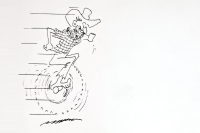Kingsbury gives us a comfortable summer read
 In The Bridge (ISBN 978-1-4516-4701-3, $19.99), Karen Kingsbury treats readers to a tale of romance and tribulation centered on a bookstore in Franklin, Tenn. Molly Allen and Ryan Kelly meet at Nashville’s Belmont University, where they become best friends.
In The Bridge (ISBN 978-1-4516-4701-3, $19.99), Karen Kingsbury treats readers to a tale of romance and tribulation centered on a bookstore in Franklin, Tenn. Molly Allen and Ryan Kelly meet at Nashville’s Belmont University, where they become best friends.
Over time, they realize that they have fallen in love with each other. Their love is enhanced by the owners of the bookstore, The Bridge, who provide Molly and Ryan with advice, good books, and a romantic meeting place.
Unfortunately, Molly’s father, a wealthy plutocrat living in Oregon, forces his daughter to leave school when he learns of her growing attachment to Ryan. Home again, she enters her father’s business under duress, though she does manage to avoid marrying the man her father has selected for her. The heartbroken and confused Ryan gains some renown as a country musician, but after seven years he and his career have hit a dead-end.
Meanwhile, Charlie and Donna Barton, the owners of The Bridge who have given much of themselves both to their bookshop and to he community of Franklin, have also come on hard times. The floodwaters that slam through Franklin ruin the store, and Charlie himself is hospitalized with heart failure brought on by the stress of trying to save his business.
To relate the rest of this story would be to reveal the ending. The Bridge is not in any way a remarkable story — judging from the long list of her publications, Kingsbury might be said to manufacture rather than to write books — yet it does make a good read for a summer afternoon at the beach or in a hammock, and will appeal to those who enjoy light romance.
•••
Related Items
I had looked forward very much to the publication of Helen Smith’s Men On Strike: Why Men Are Boycotting Marriage, Fatherhood, and the American Dream—and Why It Matters (ISBN 978-1-59403-675-0, $23.99). Smith, a doctor of psychology specializing in forensics and men’s issues — a striking combination of interests — writes for several blogs which I enjoy, and her various essays always struck me as insightful. Moreover, the topic — the interaction between the sexes and the role of men today — is one on which I myself have written several articles. Finally, Smith lives just over the mountains in Knoxville, and is therefore closer to home than most commentators I follow.
The good news is that Smith, through her use of data, interviews, and personal anecdotes, gives readers a greater understanding of why fewer young men these days are going to college, why many men are taking less of an interest in marriage and the family, and why, in a pattern which we are just beginning to understand, so many men are “going Galt,” a phrase taken from Ayn Rand’s Atlas Shrugged meaning to go on strike.
Unlike most other books and articles addressing this situation, Smith neither blames men for their predicament, unless they themselves are too cowardly to stick up for themselves and their rights, nor does she accuse them, as some have, of being grownup adolescents, refusing to take on the burdens and responsibilities of manhood. Instead, she looks at the ways various systems now treat men. She demonstrates that the laws regarding marriage and the custody of children are inherently biased against men. She looks into the classroom and reveals why boys today struggle so much in school while girls thrive. She reveals the bias of the media, particularly in television, against men and fatherhood, and shows how the ongoing destructive portrayal of men in so many commercials and situation comedies has become a stereotype for men in general.
Men On Strike has sparked some healthy debates on online blogs and websites. Here even the casual reader can find evidence, nearly all by way of personal stories, of men who have lost their homes and families because their wives decided to divorce them, of men sued for child support who are not the fathers of the children in question, of students who entered college only to find classroom and campus so biased toward females that they threw up their hands in disgust and voted with their feet against a university education.
Smith is also a pleasure to read because she clearly enjoys the company of men. From her description of her encounters with the men cited in the book she clearly sympathizes with men in their defeats and relishes their triumphs.
The biggest disappointments in Men On Strike are the quality of the writing and some of suggested remedies. Too often Smith is repetitive in making her points, telling us over and over again that the courts are the enemies of males, that men are retreating, that different systems treat men unfairly. In addition, though Smith offers some helpful advice on how men can overcome some of the handicaps thrown into their path, her repeated admonitions regarding family law and how men need to pay attention to its abuses occasionally make marriage or relationships look more like the dickerings of a pair of lawyers than the exchange of vows. Some of her advice, such as urging men to learn the laws about their state’s reproductive rights, may be heeded by a man of forty, but a twenty-two year old is unlikely to become a bedroom barrister.
Despites these criticisms, Men On Strike is a valuable addition to the literature on men. And it is not simply a book for men. By its format and subject matter, it should appeal as well to all women concerned about the role of men — fathers, husbands, sons, lovers — in their lives.









